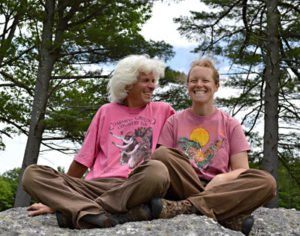 |
| Eric and Becky Sideman in a rare moment of sitting – on a granite boulder in the middle of one pasture. |
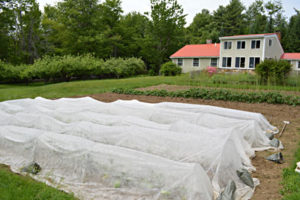 |
| The 80- by 100-foot garden in spring. Vegetables are rotated between this garden and the smaller one near the house. |
Text and photos by Jean English
Many of us know Eric and Becky Sideman in their capacities as farm-scale advisors: Eric as MOFGA’s organic crop specialist and Becky as Extension professor/specialist in sustainable horticulture production at the University of New Hampshire. Both present regularly at MOFGA’s Farmer to Farmer Conference and at other events geared toward farmers.
But the Sidemans also work with gardeners – and they embrace the homesteader side of the MOFGA community on their own 10 acres in Strafford, New Hampshire. Here, on their zone 5a, 800-foot elevation, MOFGA certified organic East Wind Farm, they raise small commercial crops of strawberries and tomatoes as well as almost all the produce, eggs and meat they eat.
“Sometimes I buy mushrooms or an avocado,” says Eric, adding, “It’s embarrassing when you get to the checkout counter and all you have is beer and toilet paper!”
Becky quips, “We’ll be a lot better when we’re brewing our own.”
The Sidemans moved to their home in 2009, choosing it for its house (originally a hunting lodge) that needed little work, its barn and shop/garage, and its location near the University of New Hampshire. The rich, loamy soil was already growing a weeping cherry, apples and pears. They added peaches, sour cherries and plums (including ‘Castleton’, a Stanley type plum) to the tree crops.
Home Vegetable Gardens
Vegetable crops rotate between two gardens – one, about 40 x 60 feet, is growing Solanaceous plants this year, along with asparagus. The bigger garden – about 80 x 100 – grows corn, beans, dry beans, cucurbits, artichokes, sweet potatoes, parsnips, garlic and more.
The two gardens produce “way more than we need,” says Becky.
“We haven’t eaten more than a quarter of the garlic we produced last year,” adds Eric.
Cucurbits start the season under row cover held down with plastic mesh bags from Uline. The bags are filled with soil and emptied right onto the garden when the row cover comes off. Becky says they do a good job of holding the row cover in place, while plastic grocery bags fall apart.
Eric – “a corn fanatic,” according to Becky – transplants their sweet corn. He says his new favorite early variety is ‘Espresso,’ a 70-day hybrid from Fedco. They also grow ‘Luscious’, ‘Montauk’ and ‘Bodacious’. They aim for their first picking for Becky’s father’s birthday – July 16 – so that they can bring lobster and corn to him then. (See Eric’s article about his sweet corn growing system in this issue of The MOF&G.)
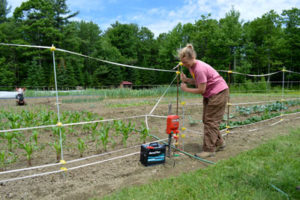 |
| The 80- by 100-foot garden in spring. Vegetables are rotated between this garden and the smaller one near the house. |
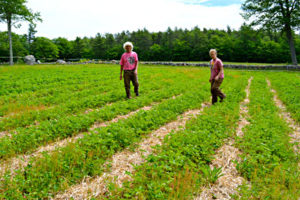 |
| The strawberry planting in its second year – to be turned under and cover cropped after harvest. |
Their flint corn grows in a separate garden, to avoid cross pollination.
For sweet potatoes, Becky buys slips in bulk and shares them with friends and neighbors. She grows the crop under black plastic mulch.
Becky is also trying to grow a black-seeded garbanzo bean. She has failed three times because of botrytis, but a friend has had good luck with them, so she’s convinced the fourth time will work!
Becky also grows some flowers, including peonies and sunflowers, for bouquets for their own home.
They save seed of some cut flowers, lettuce, flint corn, all of their beans (dry, soy, green) and garlic.
Tomatoes and Strawberries for Sale
Tomatoes, grown in a 19- by 44-foot Ledgewood high tunnel, include ‘Geronimo’, ‘Jet Star’ and ‘Big Beef’. Most are ‘Geronimo’ because of its resistance to leaf mold. ‘Jet Star’ and ‘Big Beef’ succumb quickly to leaf mold but ripen a little earlier.
The plants are started in the house in early February. In early March, the Sidemans start heating the first 10 feet of the tunnel, which is separated by a plastic sheet from the rest of the tunnel then, and they move the tomato seedlings to that part of the tunnel. In the first or second week of April, plants are set 18 inches apart in soil in the tunnel.
They sell most of their tomatoes to Philbrick’s Fresh Market in Portsmouth – about 1,000 pounds at $3 to $3.50 per pound. So they gross about $3,500 from the tunnel and spend about $1,000 to heat it.
That $1,000 expense is largely defrayed by vegetables they grow in the tunnel for their own consumption. This year they’re growing cucumbers in pots in the tunnel for the first time. They started the plants in early April and were eating cukes by early June.
“This house is most fun in the winter,” says Eric. In late July they plant a row of carrots, and later, a row of sprouting broccoli, and a lot of spinach and arugula in order to have salad all winter.
The tunnel is also educational. “One of the major reasons we do this high tunnel growing,” says Eric, “is that we like to try something before we talk about it.”
Their other commercial crop is half an acre of strawberries, sold as pick-your-own. Eric has decided to rotate this crop in time rather than space, since they don’t have another plot where they can grow strawberries. So they will plow under the crop after it produces this year (its second year of picking) and will cover crop there for the next year and a half.
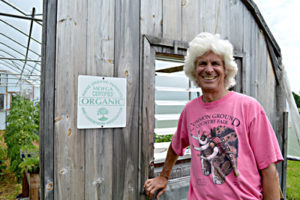 |
| Perhaps MOFGA’s best known certified organic farmer! |
 |
| Tomatoes and cucumbers inside the tunnel in early June. |
“We’ll have really cranky customers,” says Becky.
“It’s a terrible marketing scheme,” adds Eric. But it seems to be their only option to have a good rotation, which will help control weeds and insect pests, without getting more land.
They grow ‘Sable’, ‘Annapolis’, ‘Honeye’’, Sparkle’, ‘Mesabi’, ‘Cavendish’, ‘Wendy’ and ‘Daroyal’. Eric notes that ‘Sable’ performed best in two years of trials for Dave Handley, UMaine Extension vegetable and small fruit specialist, but most of the big suppliers don’t carry it. G. M. Allen Nursery in Nova Scotia trucks ‘Sable’ plants to large U.S. growers – so Eric hooks up with other growers to get his plants.
Meat, Eggs, Wool
Eric started raising sheep years ago with animals he got from MOFGA members Dennis King and Tom Settlemire – hence he thinks of their current flock of a dozen animals as Columbia Cheviot and Suffolk breeds; but Becky says “they have a fair amount of Romney in them now.” Eric concedes that “Becky, being a geneticist, has shown me how few of those original genes are there.” The animals are raised for meat and wool. (Becky spins and knits.) Of the dozen present in summer, seven ewes are kept over the winter.
The sheep live in the barn over winter and rotate through more than a dozen paddocks the rest of the year – some paddocks bordered by beautiful stone walls built by a previous farm owner, a stone worker. Fencing from Wellscroft supplements the stonework. Two woods pastures can be grazed for a day or two each – “nice on a hot day,” says Eric.
To supplement their paddocks, the Sidemans rent land from a neighbor for temporary day pasture. They rest their paddocks for about two weeks in spring and about four weeks in July and August. Eric says that about an acre of good pasture is needed for five sheep. Becky notes that they have about 2 acres of mediocre pasture on their own land – not quite enough for their flock, and hence the rented land.
The sheep are all named. “We name our sheep after famous people who have died that year,” says Eric. “This is Richie Havens. Phoebe Snow is out there.”
“Etta James is out there,” Becky adds.
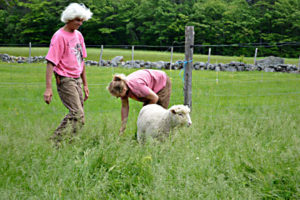 |
| Eric and Becky help Rayette onto new pasture. |
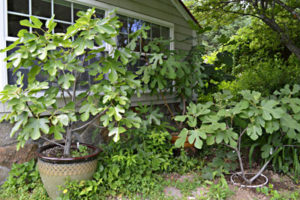 |
| The fig “trees”! |
And then there’s Rayette.
“One of my favorite movies is ‘Five Easy Pieces’,” says Eric, “and Karen Black died this year. Karen was Jack Nicholson’s girlfriend in the movie. In the movie her name was Rayette. We didn’t like the name Karen so we named her Rayette. She has one eye that looks like it has mascara.”
Becky qualifies this naming business. “It’s sort of a way to memorialize people, and keep their memory alive. We wouldn’t name them after people who don’t deserve to have sheep named after them.”
In May, after the sheep are moved outdoors, some 50 Cornish Roaster broilers occupy the barn, with access to adjacent pasture. Turkeys replace the broilers in June, when the broilers go into the freezer.
Most of the laying hens, also in the barn, are Welsummers, which lay beautiful, dark eggs. Other layer breeds at East Wind Farm are Delawares, Speckled Sussex, Speckled Sussex x Rhode Island Red and Cuckoo Marans.
The Sidemans sell some turkeys, lamb and yarn.
Small Fruit and Hops
A row of about a dozen highbush blueberry plants – ‘Patriot’, ‘Nelson’, ‘Blueray’, ‘Duke’ and ‘Jersey’ – provides plenty of berries. A caterpillar tunnel frame (an inexpensive, low-tech, temporary type of hoophouse) covered with bird netting protects the ripe fruit from birds.
Raspberries include the summer varieties ‘Taylor’ and ‘Killarney’ and the fall varieties ‘Anne’ and ‘Autumn Britten’. Killarney, in a somewhat wet spot, is not doing well and will be replaced by kiwis. ‘Michigan State’ and a Meader male kiwi already grow in this small-fruit garden.
‘Triple Crown’ thornless blackberries have produced some good crops but are very winter sensitive, says Becky, “and spotted wing drosophila get them so bad that they’re not worth it for me.”
About 12 kinds of wine, table and Concord-type juice grapes are grown for eating, juice and jelly. “I work with grape growers,” says Becky, “so I had to know about pruning grapes. I have learned a lot from my own little grape collection.” The Sidemans brush Japanese beetles into a jar of soapy water almost every morning once the insects appear but find that if they miss one or two mornings, the beetles decimate the leaves. Control is especially difficult because the beetles reproduce in the neighbor’s field. “We did get one really great harvest, and I’m sure we’ll get another one,” says the always optimistic Becky.
A small planting of rhubarb rounds out the small fruit plantings – except for the fig grove. Six potted fig plants overwinter in the basement, are moved to the high tunnel around March 1, and then go outdoors. While some fig varieties need to be pollinated by the fig wasp, these five varieties self-pollinate. Becky got the plants from fig aficionado Kerry Sullivan of Laconia (featured at https://issuu.com/dailysun/docs/lds6-26-12/15). Each plant produces a couple of quarts of figs. Eric raves about eating fresh figs and cream – sometimes with blueberries – for breakfast. Becky prefers the sweeter dried figs. She is thinking of trying to work with figs as a commercial crop, palletized and moved inside for winter and out for summer. The plants can be propagated by cuttings.
The Sidemans used to make their own beer and plan to start again, now that have a new sink in their new mudroom. Three ‘Cascade’ hops plants, each trained to two vines, are doing well and will supply that ingredient.
Equipment
An International tractor is the workhorse, used for jobs such as bush hogging and moving heavy loads. But the brand new (well used) Allis-Chalmers G is the tractor of Eric’s dreams – the gift he jokingly had suggested MOFGA give him when he retires, but he found it before that time. (“Now I want a flail mower,” Eric hints.) He had just attached a furrower – a gift from MOFGA’s late executive director, Russell Libby – and used it to make furrows for planting potatoes that morning. Russell “was just one of those guys who gave things away,” Eric reminisces.
Becky and Eric’s woodworking shop sits above the tractor garage and is a result of the couple’s desire to buy a Stickley Morris chair. “They were $3,000,” says Eric, “so we took less than that and bought the tools” – and Becky made the chair.
Our morning ends with lunch – with most ingredients coming from the farm, including Anadama bread Becky had baked that showed flecks of the flint corn they had grown. The lovely meal was a delicious and satisfying conclusion to a delightful homestead tour.
